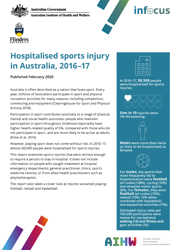Summary
Australia is often described as a nation that loves sport. Every year, millions of Australians participate in sport and physical recreation activities for many reasons, including competition, commuting and enjoyment (Clearinghouse for Sport and Physical Activity 2018).
Participation in sport contributes positively to a range of physical, mental and social health outcomes: people who maintain participation in sport throughout childhood reportedly have higher health-related quality of life, compared with those who do not participate in sport, and are more likely to be active as adults (Eime et al. 2016)
However, playing sport does not come without risk. In 2016–17, almost 60,000 people were hospitalised for sports injuries.
Across all sports, 10% of people admitted to hospital due to a sports injury had life-threatening injuries. The sports with the highest proportions of life-threatening cases were Swimming and diving (27%), Cycling (24%), Equestrian activities (24%), Wheeled motor sports (21%) and Recreational walking (19%).
Recreational walkers tend to be older than participants in most other sports: it is estimated that nearly two-thirds are aged 45 and over. More than half of walkers hospitalised in 2016–17 were aged 65 or over.
This report examines sports injuries that were serious enough to require a person to stay in hospital. It does not include information on people who sought treatment at hospital emergency departments; general practitioner clinics; sports medicine centres; or from allied health practitioners such as physiotherapists.
The report also takes a closer look at injuries sustained playing football, netball and basketball.
-
Who is most likely to be hospitalised for a sports injury?
-
What type of sport were people playing when they were injured?
-
Fractures are the most common injury
-
Half of injuries are caused by falls or crashes
-
1 in 10 sports injuries are life threatening
-
Football injuries
-
Netball and basketball injuries
-
What are the challenges to reporting on sports injury?
-
Where do I go for more information?
End matter: Acknowledgments; Glossary; References



